
I tok this picture while walking down 9th street in Brooklyn where it slopes from 5th Ave down to the Gowanus Canal. This stretch of the lower Slope has fascinated me recently, since it remains quasi-industrial, with a half-dozen cheap and primarily blue-collar bars, just around the corner from the flashy restaurants and hipster bars along 5th Ave. The street is an outpost of industrial, pre-gentrification Brooklyn, a reminder of the blue-collar sensibility which lingers in Park Slope in the form of cheap diners, bars like the Carriage House and Farrells, the sweep of this blocky, utilitarian street down to the elevated railway lines of Smith-9th Station, and the factory and warehouse buildings along the Gowanus Canal.
And there, next to a bunker-like post office, is the Big Blue House.
I’d walked by the house countless times before, but this time it was cast in yellow light from one of those spectacular New York sunsets and I had to take a couple of shots. As I was putting my camera away, a middle-aged woman standing by her porch said: “If I had a dollar for every time someone takes a picture of that house, I’d be a millionaire.”
I laughed and we started talking. She said she was always out on her stoop, that she’d been in the area for decades, that she was ‘the mayor of 9th Street’. She thought the changes over the last few years were pretty good: “Brooklyn’s coming back – for so long it was a place no one wanted to come to, but look at Park Slope now . . .”
She said the Blue House used to be an ink factory, that tunnels had once run from the basement right up to Prospect Park because the house had been used as a conduit for runaway slaves. Now, it was a music academy, Slope Music.
When I got home, I googled the Big Blue House, and found a post on Gowanus Lounge (Blue Jewel Revealed), and thebigbluehouse, run by Jake Rockowitz, a web designer who grew up in the house. At one time the site had a photo tour of the interior of the house, but now it seems to have been stripped down to a Portfolio site. Mr. Rockowitz writes:
“… The big blue house is a central theme to my artwork. Sitting in front of a computer in the basement of this big blue house is where I learned how to build websites so it seem fitting to call my company, which I incorporated in 2000, ‘The Big Blue House Production’.”
And from website for Slope Music (where you can still see pictures of the house’s interior, like the one below):
“The building inspires a sense of history because it was built in 1850, before the brownstones, before Prospect Park, before the Brooklyn Bridge. The house is awash in music because its owners, Vita and Charles Sibirsky, who moved there is 1981, started a music school called Slope Music. Since those days Slope Music has grown to include a staff of a dozen teachers, each one bringing their owns special gifts to the art of teaching music and making each student’s learning experience a personal adventure.
“…Vita’s studio is the cupola at the top of the building. When the afternoon light filters through the 13 windows, one feels like they are momentarily suspended above the building. Vita tries to create a warm, welcoming space for the students. The unusual setting encourages people to relax and be open to learning. The unique space makes every lesson special.
“People need more good music in their lives. They need to make it and to learn to listen. This improves them in every way, physically, emotionally and spiritually. Music relieves the stress people feel in these times,” Charles says.”
 Piano on top floor of blue house (from Slope Music website).
Piano on top floor of blue house (from Slope Music website).
According to the Gowanus posting, the house was built in 1855, when this area of Brooklyn must have been mostly rural, and predates the brownstones which now dominate the area. The house was designed by Patrick Charles Keely, an Irish immigrant who designed some 500 Catholic Churches in the US. The posting makes no mention of underground tunnels or abolitionists, but it does mention the ink factory, which was housed in the big brick building behind the house – the big blue house was the factory office. The ink factory has now been turned into condos, but I was heartened to see that the Big Blue House has retained elegance, charm, and culture.
That’s the thing about areas like Park Slope: gentrification can never entirely erase history, nor the area’s natural beauty. I’ll be running a few more snapshots from Park Slope’s (and Brooklyn’s) surprising history in the weeks to come.
Read Full Post »



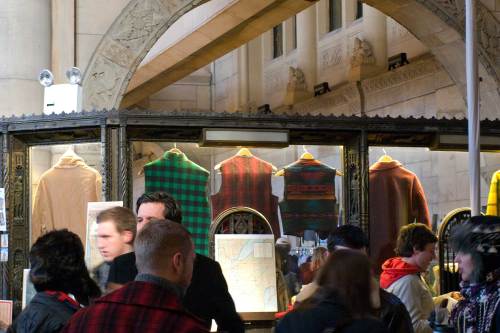











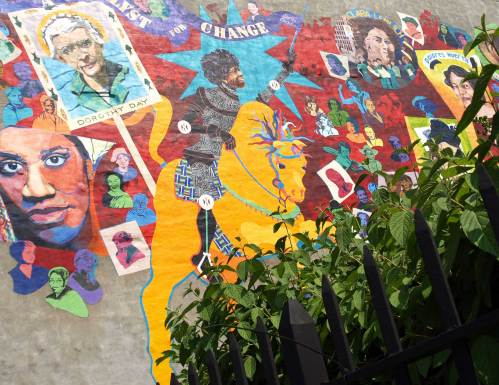

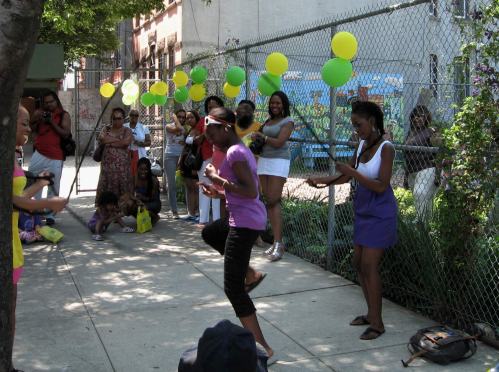

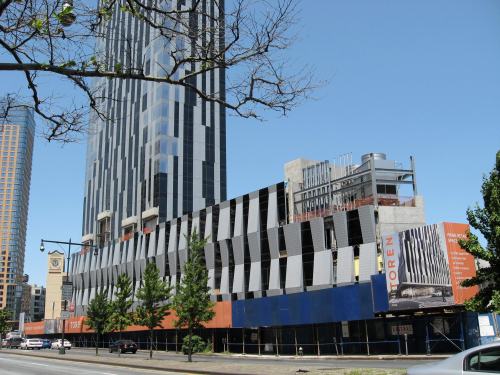


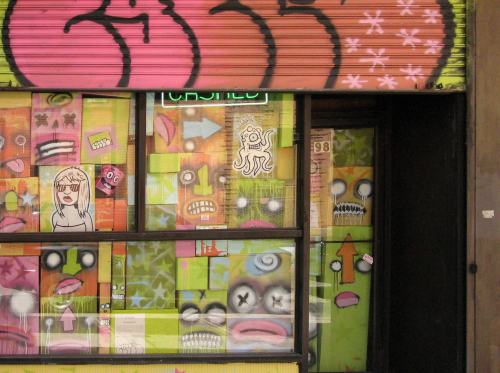




Where is New York At #47
Posted in Comment, Gentrification, New York, tagged Brooklyn, New York, Recession, Wall Street on March 4, 2010| 5 Comments »
A guy at my Manhattan watering hole, a theatre director and Soho resident since the 70’s, claims this is the most interesting time to be in New York sicne, well, the 70’s. “Everyone’s moving out of the city, no one knows what’s going to happen . . . ”
I don’t see the 70’s, or what I know of the 70’s in New York, just yet. If anything Manhattan and central Brooklyn feel like more of the same – more gentrified, less life around the edges, more of a homogenization I’ve never seen in New York before. Wall Street still pays out the big bonuses, and another bar regular who runs a high end catering business says business is up, that his Wall street clients are back splashing out for the big events.
Yet everyone I know is broke. Not desperate, not yet, but I wonder where they’ll be if this continues for a year. In my corner of central Brooklyn new cafes, increasingly upscale, are opening up and middle class white folks with babies are moving in even as the great condo binge edges threatening to transform the neighborhood crawls to a stop – some days a half dozen workers show up to work on a fifty unit building, and a 20 unit building completed last year sits empty, threatened with foreclosure, on the chopping block for a million and a half – for the whole building. Yet despite the recession, and the increasing gentrification, the still mostly working/ lower-middle class black folk in my neighborhood, by and large have retained the optimism they picked up after Obama was elected. Though I wonder too how much longer that will continue if things continue . . . .
A friend with relatives down on Wall street said the feeling is that the street will not return to anything like its pre-Crash level anytime soon. In the Atlantic, Richard Florida (the Creative Class guy), writes that New York will have to re-define itself beyond Wall street once again.
Regardless, I don’t think I’ve ever had a harder time reading New York. I’ve never seen the city so withdrawn, so homogenized – so like everywhere else. Nathan Kensinger, in his excellent post, The Bloomberg Era Pt. 1, maps out a scale of development that rivals the changes brought about by Robert Moses. I was away for most of the development period, returning for a few months at a time and often with a year or so in-between, and so experienced these changes almost second-hand. Beyond the deflation that came with Bush’s re-election, I did notice a change setting in in late 2006 – people I knew here began to withdraw into smaller and smaller circles, my favorite bars in Brooklyn and Manhattan became more homogenized, and that wonderful New York quality of random contact and possibility began to go on the retreat. And many people I knew started leaving the city, a process which is still going on now.
Yet that cycle is over, and another is about to begin. If New York feels sometimes like just another city now, I’m sure that in one year, two, it will be something else entirely.
Guy down on Wall street last summer:
Read Full Post »